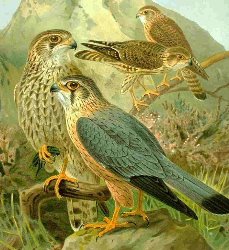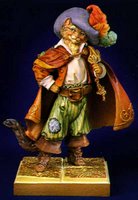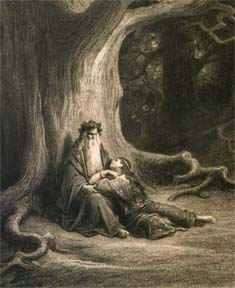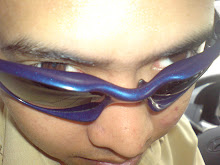
Merlin first appears in extant records (Armes Prydein, Y Gododdin) from the early 10th century as a mere prophet, but his role gradually evolved into that of magician, prophet and advisor, active in all phases of the administration of
King Arthur's kingdom. He was apparently given the name Emrys (or Ambrosius) at his birth in Caer-Fyrddin (Carmarthen). He only later became known as Merlin, a Latinized version of the Welsh word, Myrddin, taken from the place of his birth.
Geoffrey of Monmouth is thought to have invented this form (as he did so much else), since he did not want his character to be associated with the French word, merde, meaning "excrement."
Merlin was the illegitimate son of a monastic Royal Princess of Dyfed. The lady's father, however, King Meurig ap Maredydd ap Rhain, is not found in the traditional pedigrees of this kingdom and was probably a sub-King of the region bordering on Ceredigion. Merlin's father, it is said, was an angel who had visited the Royal nun and left her with child. Merlin's enemies claimed his father was really an incubus, an evil spirit that has intercourse with sleeping women. The evil child was supposed to provide a counterweight to the good influence of Jesus Christ on earth. Merlin, fortunately, was baptized early on in his life, an event which is said to have negated the evil in his nature, but left his powers intact. The original story was presumably invented to save his mother from the scandal which would have occurred had her liaison with one Morfyn Frych (the Freckled), a minor Prince of the House of Coel, been made public knowledge.
Legend then tells us that after the Roman withdrawal from Britain and the usurpation of the throne from the rightful heirs,
Vortigern was in flight from the Saxon breakout and went to Snowdonia, in Wales, in hopes of constructing a mountain fortress at Dinas Emrys where he might be safe. Unfortunately, the building kept collapsing and Vortigern's house wizards told him that a human sacrifice of a fatherless child would solve the problem. One small difficulty was that such children are rather hard to find. Fortunately for Vortigern's fortress, Merlin was known to have no human father and happened to be available.
Before the sacrifice could take place, Merlin used his great visionary powers and attributed the structural problem to a subterranean pool in which lived a red and a white dragon. The meaning of this, according to Merlin, was that the red dragon represented the Britons, and the white dragon, the Saxons. The dragons fought, with the white dragon having the best of it, at first, but then the red dragon drove the white one back. The meaning was clear. Merlin prophesied that Vortigern would be slain and followed on the throne by
Ambrosius Aurelianus, then Uther, then a greater leader, Arthur. It would fall to him to push the Saxons back.
True to the prophecy, Vortigern was slain and Ambrosius took the throne. Later, Merlin appears to have inherited his grandfather's little kingdom, but abandoned his lands in favour of the more mysterious life for which he has become so well known. After 460 British nobles were massacred at a peace conference, as a result of Saxon trickery, Ambrosius consulted Merlin about erecting a suitable memorial to them. Merlin, along with Uther, led an expedition to Ireland to procure the stones of the Chorea Gigantum, the Giant's Ring. Merlin, by the use of his extraordinary powers, brought the stones back to a site, just west of Amesbury, and re-erected them around the mass grave of the British nobles. We now call this place Stonehenge.
After his death, Ambrosius was succeeded by his brother, Uther, who, during his pursuit of
Gorlois and his irresistable wife,
Ygerna (Igraine or Eigr in some texts), back to their lands in Cornwall, was aided by Merlin. As a result of a deception made possible by Merlin's powers, Uther was transformed into the image of Gorlois. He entered their castle, managed to fool Ygraine into thinking he was her husband, had his way with her and in the course of things, conceived a child, Arthur. Poor Gorlois, not knowing what was going on, went out to meet Uther in combat, but instead, was slain by Uther's troops.
After Arthur's birth, Merlin became the young boy's tutor, while he grew up with his foster-father, Sir Ector (alias Cynyr Ceinfarfog (the Fair Bearded)). In the defining moment of Arthur's career, Merlin arranged for the sword-in-the-stone contest by which the lad became king. Later, the magician met the mystic
Lady of the Lake at the Fountain of Barenton (in Brittany) and persuaded her to present the King with the magical sword, Excalibur. In the romances, Merlin is the creator of the Round Table, and is closely involved in aiding and directing the events of the king and kingdom of Camelot. He is pictured by Geoffrey of Monmouth, at the end of Arthur's life, accompanying the wounded Arthur to the Isle of Avalon for the healing of his wounds. Others tell how having fallen deeply in love with the Lady of the Lake, he agreed to teach her all his mystical powers. She became so powerful that her magical skills outshone even Merlin's. Determined not to be enslaved by him, she imprisoned the old man in a glass tower, a cave or similarly suitable prison. Thus his absence from the Battle of Camlann was ultimately responsible for Arthur's demise.
 Common Name: Merlin FalconOther Common Names: Pigeon HawkScientific Name: Falco columbariusGroup: LongwingOrigin or Range: EurAsiaRelative Size: smaller than average
Common Name: Merlin FalconOther Common Names: Pigeon HawkScientific Name: Falco columbariusGroup: LongwingOrigin or Range: EurAsiaRelative Size: smaller than average (as compared to other raptors)
Average Lifespan: 7 yearsCategory: Raptors
An extremely clever and ambitious bird, the Merlin Falcon may catch prey, which is as large as itself! Used in falconry since the Middle Ages, the Merlin Falcon is one of the loveliest and most interesting raptors.
Though the Merlin Falcon has an extensive native range, these birds are not as common as other raptors, and unlike other raptors, they do not mate for life. Also called the Bullet Hawk or Pigeon Hawk, the Merlin Falcon has an unusual manner of hunting, which earned it that name. The Falcon will fly slowly at low altitudes or wait on a tree branch until it sees its prey, at which point it will slowly begin to fly after it. The quarry probably believes that the Merlin Falcon is a pigeon or other slow bird, and does not flee; when the Merlin Falcon is close, it suddenly darts in to snatch the unsuspecting prey. The prey is usually a small bird, starlings being a favorite food, but Merlins will also take very small mammals, lizards and invertebrates. A highly territorial bird, Merlin Falcons will challenge and harass other birds who attempt to near it, even other raptors who may be much larger than itself. The Merlin Falcon of North America frequently migrates during the winter to southwestern, warmer climates. There are four different subspecies of Merlin Falcon on that continent: the Bendire's Merlin, Richardson's Merlin, American Merlin, and Black Pigeon Hawk, differentiated by varying coloration and preferred migratory locale. Normally silent, the lovely Pigeon Hawk will emit a shrill, "ki-ki-ki" cry when alarmed or breeding. Each year, Merlin Falcons return to a general area, which is designated as the breeding area, but depart again, alone, after the breeding season is over. This beautiful bird has been used in falconry throughout the ages, and is still a great favorite because of its speed and tactics. However, falconers often find the lovely Merlin impatient and its bodyweight difficult to maintain and hybrids, which are easier to care for, have been developed. The agile, intelligent Merlin Falcon may live up to seven years in captivity.
Because of its coloration, the Pigeon Hawk has been nicknamed the Little Blue Corporal! However, only the male Merlin Falcon has blue coloration on his back, and this may even be grayish. The female is mostly brown, as are young Merlin Falcons. These birds are small, measuring 25 to 30 centimeters with a wingspan of 50 to 65 centimeters. The wings are pointed and compact. As with all raptors, the female is larger than the male. The undersides of the Merlin Falcons are white, streaked with brown, and tails and wings are banded white and black. There are no facial markings.
The Merlin Falcon inhabits prairies, coastlines and forests throughout North America and Eurasia. The Merlin Falcon has been bred for falconry since the Middle Ages in Europe, where it was the only bird female austringers were allowed to fly, since it was considered "dainty". This is in fact where the name "Merlin" originated, as female falconers' birds in France were known as "émerillons". Today, Merlins are threatened by loss of habitat and by bad relations with poultry farmers, as they may steal small birds.

 Merlin first appears in extant records (Armes Prydein, Y Gododdin) from the early 10th century as a mere prophet, but his role gradually evolved into that of magician, prophet and advisor, active in all phases of the administration of
Merlin first appears in extant records (Armes Prydein, Y Gododdin) from the early 10th century as a mere prophet, but his role gradually evolved into that of magician, prophet and advisor, active in all phases of the administration of 


